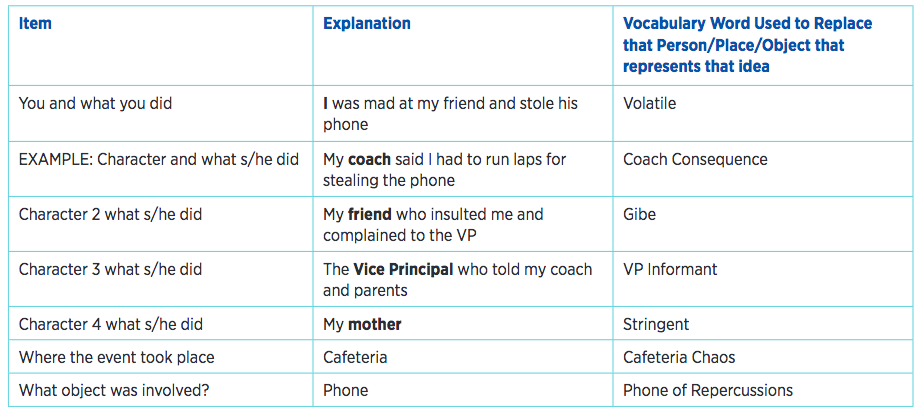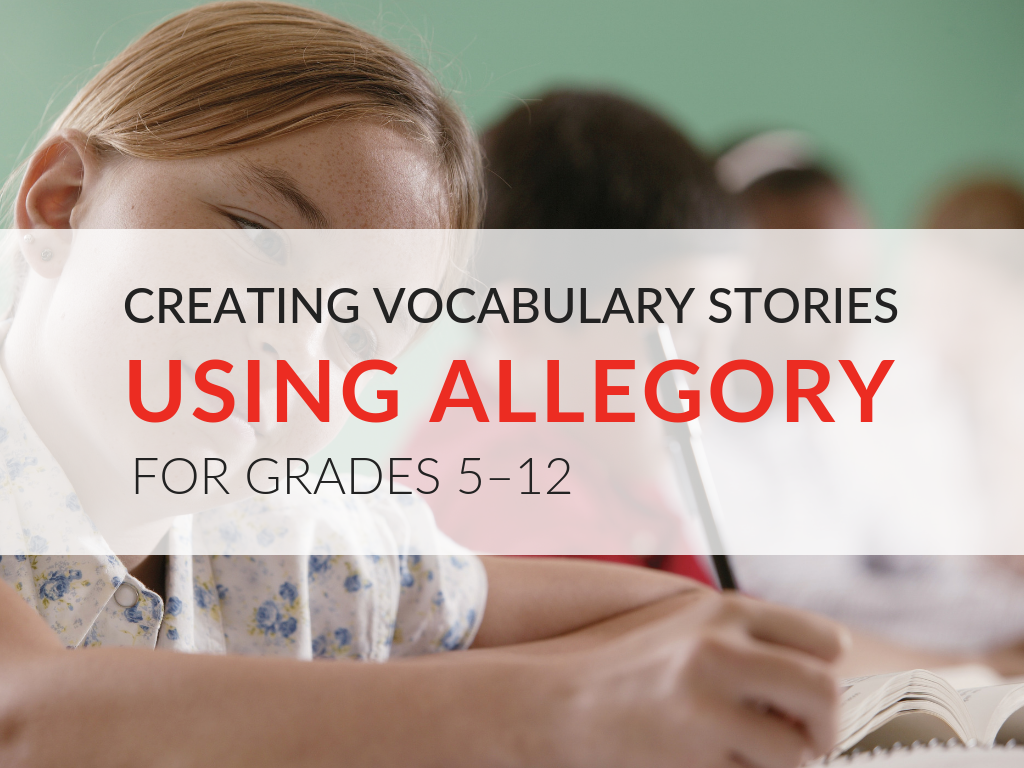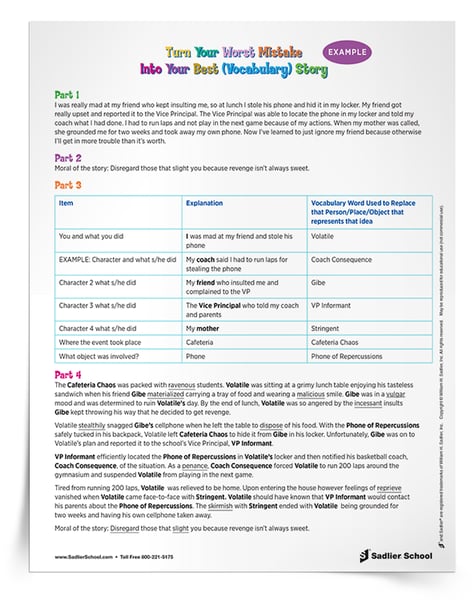November 15, 2018 VG Teaching Resources Vocab & ELA Res, VG Writing with Vocabulary 6-12, VG Writing with Vocabulary K-5, Vocab Gal, Vocabulary/Vocab Gal, ELA K-5, ELA 6-8, ELA Resources - Activities, ELA 9-12, ELA Focus - Writing with Vocabulary, ELA Focus - Vocabulary
Writing Allegory Vocabulary Stories in Grades 5–12
By: Vocab Gal
While I love reading novels with great vocabulary, it is rare that fiction inspires me to a new and unusual vocabulary lesson plan... This post shares a great story creation activity that is not only an awesome way for students to commit vocabulary words to memory, but also a way for students to learn a bit more about the literary device called allegory.
Download the Turn Your Worst Mistake Into Your Best (Vocabulary) Story Activity now!
Write Your Way into Learning Vocabulary
My children and I have been listening to the Harry Potter series in the car, and I love to pause the audiobook and discuss the ways author J.K. Rowling uses names to hint at personalities and plot points. The caretaker Argus Filch, is named after Argus Panoptes, a Greek watchman who had over 100 eyes; both, clearly, are focused on spying and keeping guard over their territory.
Likewise, Professor Snape lives at Spinner’s End, a reference to the mythological Greek witches who would spin the threads of humans’ lives and kill them by severing these cords, just as Snape and his actions lead (directly or indirectly) to the end of multiple lives in the series.
These two literary references, like so many more in the series, are wonderful teachable moments that help make sometimes archaic mythological ideas clearer. I thought that it would be great fun to have students create their own stories to help make vocabulary words stick and to their meaning become clearer.
Research shows that when students can attach new information to knowledge they already have in their long-term memory, learning is the greatest. Therefore, when students create a new, vocabulary-filled story about situations and characters that they are already familiar with, the new information and word meanings will resonate more strongly with them.
Creating Stories Using Allegory
I know what everyone is thinking—allegory? My students? I barely understand what allegories are myself! Now, teachers and administrators, do not be scared by the word allegory! An allegory is simply a story that is made more universal by making the names and actions more general.
For example, in the classic allegory, The Pilgrim’s Progress, the main character is named Christian. This name, as the book was written by Christian author John Bunyan for Christian readers, makes him the ultimate everyman.
On his journey, he meets with characters named Greed and Sloth—clearly their whole identity is implied by their names—and Christian’s rejection of them shows how all Christians should behave.
In the same way, when students write about their own past life events, they simply rename their friends, family, locations and objects using related vocabulary words that make the stories a bit more universal. By doing so, the students link their long-term memories of the people and events with vocabulary words, and can recall the words and their meanings more easily.
Furthermore, the concept of allegory is an important, but challenging, concept to teach as part of our ELA standards, so by using vocabulary words, this activity meets multiple standards—writing, vocabulary, and literary analysis.
How Students Can Create Their Own Allegory
When starting the Turn Your Worst Mistake Into Your Best (Vocabulary) Story Activity, ask students to think of a time when they did something wrong and what the major consequences of their actions were. At the top of the handout provided, students write a brief four to six sentence-long account of the situation in order to make sure they remember the key points of the event. Teachers can model this by using the example scenario provided in the download or recalling their own past event.
Next, students fill out the Story Chart Graphic Organizer section of the handout with the highlights of the story, including the people involved, the places involved, and the objects involved, renaming each with a vocabulary word that captures the “spirit” of each person, place, or object. Students may need to use the extra boxes at the end if they have fewer or more characters, locations, or objects.
Afterwards, students write a rough draft of their story, substituting their vocabulary words for the actual people, places, and events. At the end of the activity, try to have students sum up their learning to make sure the overall allegorical meaning of the story is clear.
Allegory Story Example
The Cafeteria Choas was packed with ravenous students. Volatile was sitting at a grimy lunch table enjoying his tasteless sandwich when his friend Gibe materialized carrying a tray of food and wearing a malicious smile. Gibe was in a vulgar mood and was determined to ruin Volatile’s day. By the end of lunch, Volatile was so angered by the incessant insults Gibe kept throwing his way that he decided to get revenge.Volatile stealthily snagged Gibe’s cellphone when he left the table to dispose of his food. With the Phone of Repercussions safely tucked in his backpack, Volatile left Cafeteria Chaos to hide it from Gibe in his locker. Unfortunately, Gibe was on to Volatile’s plan and reported it to the school’s Vice Principal, VP Informant.VP Informant efficiently located the Phone of Repercussions in Volatile’s locker and then notified his basketball coach, Coach Consequence, of the situation. As a penance, Coach Consequence forced Volatile to run 200 laps around the gymnasium and suspended Volatile from playing in the next game.
Tired from running 200 laps, Volatile was relieved to be home. Upon entering the house however feelings of reprieve vanished when Volatile came face-to-face with Stringent. Volatile should have known that VP Informant would contact his parents about the Phone of Repercussions. The skirmish with Stringent ended with Volatile being grounded for two weeks and having his own cellphone taken away.
Moral of the story: Disregard those that slight you because revenge isn’t always sweet. |
Finally, have peer proofreading sessions where students share story critiques about how easy the allegory is to understand and how well the vocabulary words represent the people, places, and objects in the larger context of the story.
In Summary
Ultimately, by students linking their personal memories with new vocabulary words, learning deepens and students feel more connected with the words. In crafting stories, students are practicing multiple ELA skills including plot sequencing, character development, and thematic understanding. Furthermore, students can experience writing an allegory and therefore have an inside perspective when it comes to defining this sometimes complicated concept.
Have some fun sharing with your students a problem you encountered in the past and its outcome and just see if your vocabulary prowess doesn’t increase in the process.





